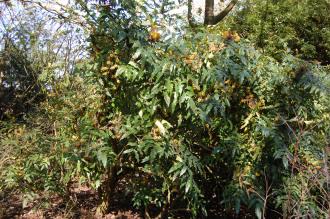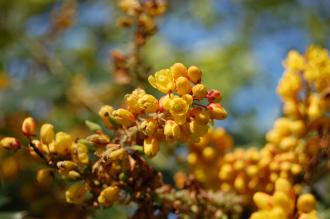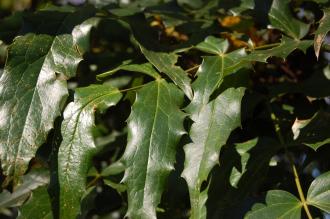
Mahonia napaulensis (16/03/2014, Kew Gardens, London)
Position: Full sun to partial shade
Flowering period: Spring
Soil: Moist, well drained
Eventual Height: 2.3m
Eventual Spread: 3m
Hardiness: 6b, 7a, 7b, 8a, 8b, 9a, 9b
Family: Berberidaceae
Mahonia napaulensis is an evergreen, shrub with a rounded bushy habit. Its mid green leathery leaves are pinnate, composed of up to 12 leaflets, up to 60cm long and 19cm broad. Its leaflets are ovate very spiky and up to 10cm long and 5cm broad. Its mildly fragrant orange/ yellow flowers are borne on terminal racemes and up to 23cm long. Its blue/ black fruit follow the flowers in the form of oblong berries.

Mahonia napaulensis Flower (16/03/2014, Kew Gardens, London)
Mahonia napaulensis, commonly known as Nepalese Mahonia or Indian Barberry, is native to the south Himalayas region. In its native habitat it grows in deciduous Oak forests.
The etymological root of the binomial name Mahonia was named by Thomas Nuttall after an Irish political refugee, Bernard M’Mahon. Napaulensis is derived from the Latin meaning ‘from Nepal’.
The landscape architect may find Mahonia napaulensis useful in shady locations including woodland planting schemes. Once established this shrub is drought tolerant. This shrub is not attractive to deer.

Mahonia napaulensis Leaf (16/03/2014, Kew Gardens, London)
Ecologically, Mahonia napaulensis flowers are attractive to pollinating insects. Its berries are eaten by birds.
Mahonia napaulensis prefers moist, humus rich, well-drained soils. It tolerates most pH of soil.
Mahonia napaulensis requires little maintenance. Some stems may be removed in May to encourage bushy habit, suckers may be removed at the same time.

